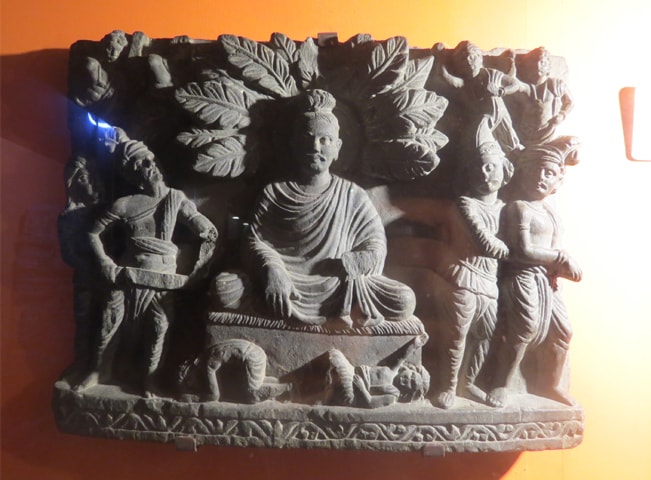In 1907, when the Victoria Memorial Hall in Peshawar became a museum, the British embarked on building a similar memorial in Kolkata (Calcutta then), India, in memory of Queen Victoria who had died in 1901. The British Viceroy in India, Lord Curzon — driven to create a fitting memorial to the Queen, also the “Empress of India” — said, “Let us, therefore, have a building, stately, spacious, monumental and grand, to which every newcomer in Calcutta will turn, to which all the resident population — European and Native — will flock, where all classes will learn the lessons of history, and see revived before their eyes the marvels of the past.”
Today, Curzon’s epithets wouldn’t be misplaced if used for the Peshawar Museum, formerly the Victoria Hall. It is “grand, stately and spacious,” and the phrase “marvels of the past” fits even better, given the cornucopia of ancient Gandhara art the museum boasts. There is little here about the British and the Raj whose memory Curzon wanted to preserve, but for the wonder and wealth of the Gandhara civilisation (1500BCE-500BCE) in all its historical and spiritual significance, Peshawar museum is the place to “flock”. This significance, universal as it is, takes on an immediate, direct relevance when you know that Peshawar and the surrounding valleys of Swat, Buner, Bajaur, Dir were Gandhara proper — the very “cradle” of that civilisation, as historians would tell you. The boundaries of Gandhara Greater go beyond up to Kabul valley in Afghanistan and Potohar plateau in Pakistan.

Before it became Peshawar Museum, says Research Officer Nawazuddin at the museum, the Victoria Memorial Hall served as a ballroom to the British army and administrators stationed here at the Governor House. An overhead bridge connected the Governor House to the hall. It still has that red-brick colonial grandeur, the kind that Raj-era buildings on the Mall in Lahore have about them. “Curzonian” is how Nawazuddin describes the architecture, after Curzon who married together the Victorian with the Mughal style. The Mughal design, in turn, blended the Buddhist, the Hindu and Islamic architecture into a synergetic whole.
The Peshawar Museum may have been established by Lord Curzon to preserve the history of the British Raj but its current uniqueness stems from its treasures of the Buddhist era in the region
“The British were treasure hunters,” says Nawazuddin. “In 1864, they established the Archaeological Survey of India to explore, identify, excavate and conserve archaeological sites. Since there weren’t any museums back then, a lot of Gandhara artefacts went to Britain and other places with no Buddhist roots, such as Calcutta, Karachi and Lahore.”

The British-Hungarian archaeologist Sir Aural Stein became the first curator of the Peshawar Museum in 1906. He, alongside Sir Francis Younghusband, was the great British explorer in service of the Raj at the height of the Great Game. Both helped extend the British political influence through archaeological explorations in Central Asia. The museum today bears no remnants from that “tournament of shadows” when Sir Aurel Stein undertook feverish expeditions to Iran, China, India and Central Asia. What it does have is the Buddhist artefacts from his excavations in the region under the Archaeological Survey of India formed in 1864. These were first curated in the museum but in no chronological order of the Buddhist era. Along came Professor Hassan Dani, who teased out of the archaeological remains the Life Story of Lord Buddha — From Birth to Death.

To enter the museum is to enter a story carved out in black stone and white lime. Here is a rock carving depicting a scene from Swabi in Khyber Pakhtunkhwa where Lord Buddha appeared as a fish during a great famine to feed his flesh to the people. Here is another of his mother Maya, having a dream that foretells the arrival of her son, Siddhartha the Sage, whose teachings would start a great religion. And another that shows the queen-mother going to her parents’ place and giving birth to Buddha at the Lumbini gardens. Then there are the ones depicting the ‘Great Departure’ when Buddha leaves the palace and the ‘Great Renunciation’. “Back then people couldn’t read,” says Nawazuddin, “and the only way to propagate a religion was to set stories in stone through carving and chiselling.”

The carvings are many, as are the stories. But the piece de resistance at the museum’s collection is the First Meditation of Siddhartha in shist, a gleaming black stone, with the great canopy of a Jambu tree over the Sage’s head. The sculpture dates back to second or third century AD. And, of course, the Fasting Siddhartha — starved, skeletal and serene, deeply spiritual in its hollow-eyed, hollow-cheeked bliss. Standing here, among sculptures small and giant of a sage so benign and yet so grand, it is hard not to feel the immense weight of history and a profound presence worthy of universal veneration. You leave the museum a little reduced in ego, which is what the Enlightened One would have wanted you to experience.



The writer is a Peshawar-based freelance journalist
Published in Dawn, EOS, September 30th, 2018















































